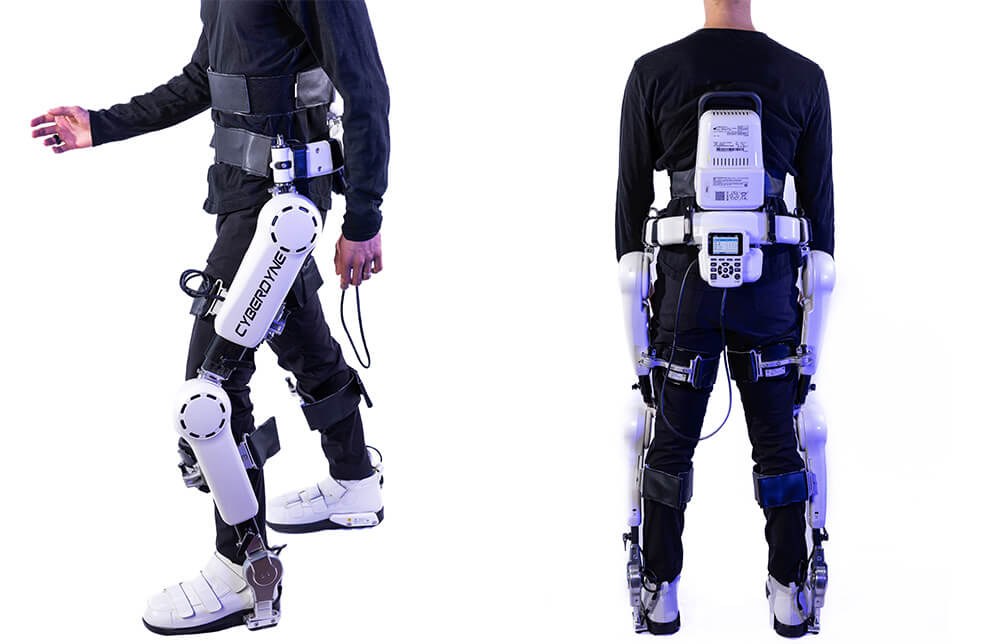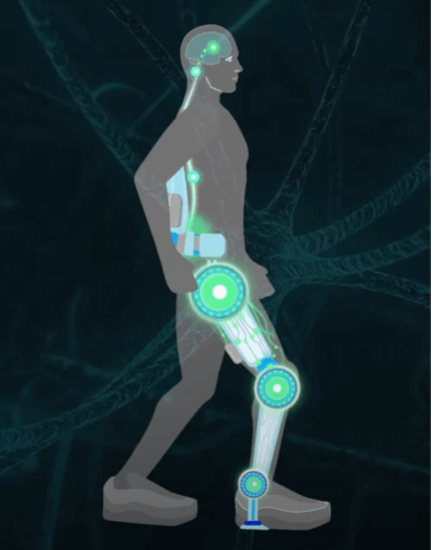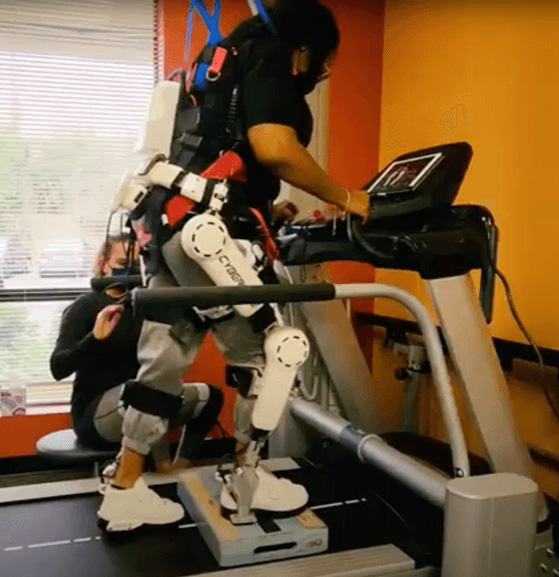
Do you know the benefits of HAL exoskeletons? HAL stands for Hybrid Assistive Limb and is a wearable exoskeleton that’s transforming people’s lives.
HAL is a non-invasive exoskeleton that senses the wearer’s intention for movement through small sensors on the skin.
This article will highlight the top impacts of the Hybrid Assistive Limb device and explain exactly how it works. Let’s dive in!
What is the Cyberdyne HAL Exoskeleton?
The Cyberdyne Hybrid Assistive Limb (HAL) is a type of robotic exoskeleton that assists users in making movements through signals sent from the brain.
When a wearer wants to move, the HAL technology detects bioelectric signals sent from the user’s brain to the user’s muscles. Once HAL detects those brain signals from small sensors on the skin, its motors turn on to help the wearer make their intended movement.
Essentially, HAL exoskeletons detect, interpret, and facilitate the user’s intended movement into actual movement patterns. If you think “right leg move” — the Hybrid Assistive Limb will help you to do it!
It is the only FDA approved exoskeleton in the U.S. that actually improves mobility and ambulation.
Top 5 Benefits of HAL Exoskeletons
HAL has the ability to help wearers relearn movement patterns and regain independence.
Here at RISE Healthcare Group we treat patients with HAL who have various illnesses and injuries such as Spinal Cord Injuries (SCI), stroke, Traumatic Brain Injuries (TBI), Multiple Sclerosis (MS), Parkinson’s, Progressive Neuromuscular Disorder, Cerebral Palsy, ALS and many more.
After helping patients recover, retain, or restore mobility by using the Hybrid Assistive Limb technology – we know how amazing the results are. Here’s a roundup of the top 5 benefits of HAL exoskeletons:
1. Hybrid Assistive Limb Exoskeletons Improve Neuroplasticity:
But first, what’s neuroplasticity? It’s the human brain’s ability to reorganize itself and form new neurological connections that replace damaged neurological connections due to diseases or injuries.
These newly created neurological pathways allow the patient to regain critical functions that would have otherwise been permanently lost.
In simple terms: your brain is relearning how to make a movement by creating new pathways!
How to Achieve Neuroplasticity
For a patient to achieve neuroplasticity, the HAL treatment must be highly specific, focused and tailored to their specific needs. That’s why RISE Healthcare Group’s physical therapists who treat patients using HAL have been trained by FDA-approved specialists.
A main benefit of the HAL exoskeleton is that it constantly collects patient data, which is key in understanding the patient’s needs. Each treatment and session with HAL becomes more patient specific — which significantly improves the process of neuroplasticity for their recovery.
The robotic assistance provided by the Hybrid Assistive Limb exoskeleton allows patients to engage in more intensive and extended rehabilitation sessions. This leads to faster progress in terms of muscle strength, endurance, and overall functional improvement.

2. Early Use Benefit of HAL Exoskeletons:
Research shows that neuroplasticity occurs most significantly within the first six months after a neurological injury. This means that patients who have experienced a stroke or spinal cord injury will demonstrate the most significant and relevant gains during the initial six-month period following the neurological event.
Once this initial period has passed, the brain’s ability to compensate and regenerate becomes exponentially more limited.
Unfortunately, current standard practice of treatment for these neurological deficits involves immobilization and heavy restrictions due to fear of falls, reinjuries, and liabilities within neurological rehab centers.
Unlike others, the HAL robotic exoskeleton can be utilized as soon as a patient is considered medically stable. It is safe and effective for early intervention and is performed within a bodyweight supported system that mitigates most fall risks.
3. HAL Exoskeletons Spark Motivation:
One of the best benefits of HAL exoskeletons is that they make therapy more engaging and motivating for patients.
Why? Because the technology offers real-time feedback, so the patients can see their progress, fostering a positive mindset with the rehabilitation process.
We have seen patients truly commit to getting better after a session with HAL and experiencing the benefits firsthand. When treated for gait and ambulation with the Hybrid Assistive Limb robotic exoskeleton, patients report significantly higher levels of satisfaction and motivation. This directly correlates to improved health outcomes when compared to standard treatment practices.
RELATED: Walking After a Stroke: How HAL Exoskeletons Can Help
4. HAL Helps You Return to Favorite Hobbies:
Patients who have experienced a neurological deficit have difficulty reintegrating with the community and doing activities they once enjoyed. This is because their injury has changed their mobility, strength, or coordination.
It can be hard and even scary at times to return to activities patients once enjoyed after an injury. Although it’s hard — community activities are a critical aspect of maintaining quality of life.
Fortunately, treatment with robotic exoskeletons like HAL are shown to significantly improve the rate at which patients return to community activities.
Hybrid Assistive Limb helps patients regain their independence and return to their favorite hobbies which improves their quality of life.

5. HAL Exoskeletons Improve Quality of Life:
HAL exoskeletons help patients improve their functional abilities, which in turn improves their quality of life. Having a higher quality of life is also associated with longer life expectancy and decreased physical and psychological impairments.
Learning how to walk again, how to get out of bed or even change your outfit can drastically change a person’s life and sense of independence.
Hybrid Assistive Limb exoskeleton treatment can enhance both the quality of life and life expectancy in neurological patients.
The Benefits of Hybrid Assistive Limb Exoskeletons are Transforming Lives
Hybrid Assistive Limb physical therapy focuses on addressing a range of factors from neuroplasticity to healthcare access, community reintegration, and overall quality of life.
Neurological rehabilitation must recognize the importance of individual experiences and perceptions in assessing well-being and HAL allows for that recognition while performing meaningful and effective intervention.
Dr. Alex Kelso, PT, DPT, FAFS, was born in Boynton Beach, Florida and is a devout Florida Gator. He graduated Cum Laude from the University of Southern California with his Doctorate in Physical Therapy in 2014. Alex has been a team member with RISE Physical Therapy since 2015, currently as Chief Operating Officer. He finds passion in learning about the activities and interests of his patients, and providing care for the body, mind, and spirit.